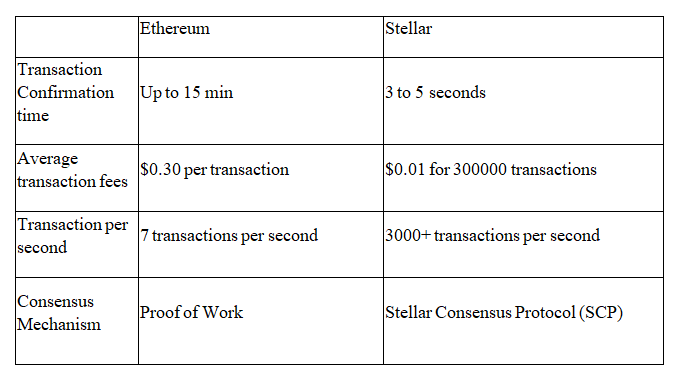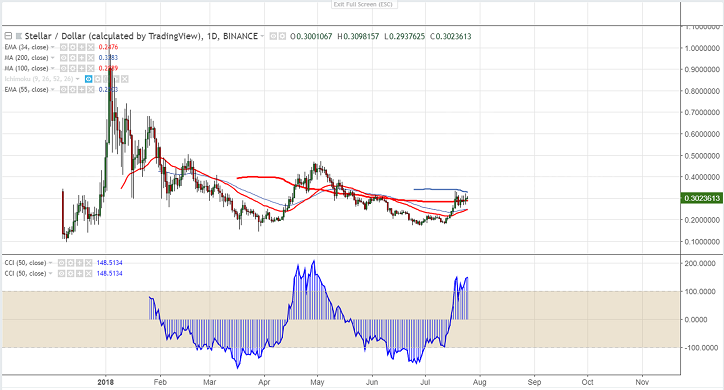Stellar is a platform that connects banks, payment systems and people reliably with no cost. Using Stellar, users can send currencies on the network to and from anywhere in the world. Stellar was born from Ripple protocol. Jed McCaleb the founder of Stellar is co-founder of Ripple.
How Stellar works
Stellar is a network of decentralized servers in many locations with distributed ledger. The ledger records every transaction in the system for the people and companies alike. The Stellar network can quickly exchange government- based currencies with 2 to 5 second processing times. The Stellar protocol will function like flexible Paypal.
One of the major features of the Stellar network is “Anchors” which will be acting as bridge between different currencies. Anchors do the role of Paypal in the Stellar network.
Stellar Network overview:
Stellar is the payment network (Horizon API and Stellar core) and lumens is crypto currency.

Stellar network has two major components
- Horizon API
- Stellar core
Horizon API:
All interactions with Stellar network can be done only through Horizon, a RESTful HTTP API server. Horizon is an Application Programme Interface (API) server for the Stellar ecosystem. It acts as the interface between Stellar core and applications that wants to access Stellar network.
Application Programme Interface (API) is an software intermediary that allows two applications to talk to each other.
It allows developers to submit transactions, check accounts balance and subscribe to events.Horizon can be used through our web browser, or using cURL, or the Stellar SDK which is a Java script library for communicating with Stellar Horizon Server.
Stellar Core:
The Stellar Core is the backbone of the Stellar network, every Horizon server connects.It does work of validating and reaching consensus of transactions.
Stellar Consensus Protocol (SCP): SCP is evolution of FBA. Federated Byzantine Agreement is a traditional process of reaching consensus. It is a model for consensus using nodes,quorum slices and quorum.
Quorum: the set of nodes required to reach agreement across the whole system
Quorum Slice: the subset of a quorum that can convince one particular node of agreement.
A Byzantine Agreement is reached when a certain number of nodes known as quorum agrees that the solution presented is correct, thereby validating a block. Ripple was the first to use FBA and Stellar actually refined this approach even further using safe FBA protocol.
Stellar Consensus Protocol Key Features
- Decentralized - Access to anyone
- Low Latency- 3 to 5 seconds
- Flexible Trust - Organization
- Asymptotic Security - Digital Signatures
Stellar network is a worldwide collection of Stellar cores which agree on sets of transactions . Each transaction costs a small fee of 100 stroops (0.00001 XLM).

News Update:
Stellar has started its strategic partnership with IBM in October 2017. Since October, IBM has been building distributed ledger products on top of Stellar for cross-border payments. The partnership further strengthens the use of Stellar. Stellar now replaces Swift, by building strong bridge.
According to latest update, IBM is providing 9 key validators for Stellar network. IBM Senior Vice President for International Industries Bridge van Kraligne confirmed that Stellar and its native asset Lumens (XLM) is currently being used by a couple of largest banks in financial exchange (FX) corridors.
IBM gave a big boost to Stellar recently. It has announced a partnership with Stronghold, a digital currency backed by US dollars on the Stellar blockchain network. IBM is currently using Stellar Lumens as a conduit for international and cross border payments.
IBM has begun testing a so-called stablecoin or “crypto dollar “ that runs on Stellar network. It is called as Stronghold dollar as start-up fintech Stronghold is behind the project.
There’s this tremendous opportunity to make block chain payments feasible, especially for cross-border,” says Bridget van Kralingen, IBM’s senior vice president of global industries, platforms and block chain. “What is great about this is they are just basically digital dollars—digital fiat currency.”
Technical:
XLM/USD has jumped more than 25% from the low of $0.2550 after IBM news on Stable coin. The pair hits high of $0.328800 on Jul 19th 2018 and is currently trading around $0.3020.
On the higher side, near term resistance is around $0.3300 (200- day MA) any break above will take the pair till $0.3850/$0.4600.
The near term support is around $0.2500 and any violation below will take the pair to next level till $0.1700/$0.1400.
It is good to buy on dips around $0.2550 with SL around $0.17 for the TP of $0.46/$0.50.




 Bitcoin Yawns at Fed Cut – Coiled Tight at $92K: $90K Hold = Straight Shot to $100K
Bitcoin Yawns at Fed Cut – Coiled Tight at $92K: $90K Hold = Straight Shot to $100K  ETH Bulls Smash Trendline – $4,000 Next as Whale Squeeze Tightens
ETH Bulls Smash Trendline – $4,000 Next as Whale Squeeze Tightens  ETH Whales on Rampage: BitMine Snags 138K ETH as $3,000 Holds Firm – Bulls Gear Up for $4,000 Moonshot
ETH Whales on Rampage: BitMine Snags 138K ETH as $3,000 Holds Firm – Bulls Gear Up for $4,000 Moonshot  Bitcoin Holds the Line at 90k: Sideways Grind with an Eye on 100k Breakout
Bitcoin Holds the Line at 90k: Sideways Grind with an Eye on 100k Breakout  FxWirePro- Major Crypto levels and bias summary
FxWirePro- Major Crypto levels and bias summary  FxWirePro- Major Crypto levels and bias summary
FxWirePro- Major Crypto levels and bias summary  FxWirePro- Major Crypto levels and bias summary
FxWirePro- Major Crypto levels and bias summary 






























